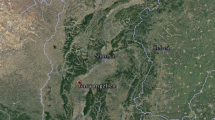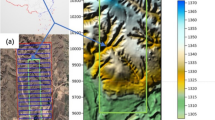Abstract
When using a Terrestrial 3D laser scanning (TLS) to monitor the mining subsidence in a mining area, the conventional methods are to set up the public target manually, or to set up the ground control network in advance. However, these have the disadvantages of high labor intensity and low efficiency. In order to overcome the shortcomings of the conventional methods, this paper presents the subsidence monitoring method using TLS without a target in the mining area. Feature points are used to splice the multi-station point clouds in the same phase, and a few station coordinates are used to uniformly transform the multiphase data into a geodetic coordinate system. Afterwards, the surface digital elevation model (DEM) is established by using the point clouds after coordinate transformation, and the dynamic subsidence value and subsidence basin during the period of observation are obtained by DEM subtraction. Compared to traditional methods, this method simplifies the field measurement process, reduces the labor intensity, and transfers the main work to the internal industry. It is suitable for surface subsidence monitoring with a harsh external environment and complicated topographic conditions. Surface deformation values are important basic data for mining area subsidence parameters acquisition, mining area environmental assessment, land reclamation, and ecological restoration. As a consequence, it is of great value to popularize and apply in mining area for subsidence monitoring.







Similar content being viewed by others
References
Altamar-Mercado H, Patiño-Vanegas A, Marrugo AG (2019) Robust 3D surface recovery by applying a focus criterion in white light scanning interference microscopy. Appl Opt 58:A101
Antova, Gergana (2015) Registration process of laser scan data in the field of deformation monitoring. Procedia Earth Planet Sci 15:549–552. https://doi.org/10.1016/j.proeps.2015.08.096
Ao J (2013) Study on key problems of processing point cloud of dynamic subsidence area from terrestrial laser scanner doctor, China University of Mining and Technology
Baiocchi V, Napoleoni Q, Tesei M, Servodio G, Alicandro M, Costantino D (2019) UAV for monitoring the settlement of a landfill. Eur J Rem Sens 52:41–52. https://doi.org/10.1080/22797254.2019.1683471
Becerik-Gerber B, Jazizadeh F, Kavulya G, Calis G (2011) Assessment of target types and layouts in 3D laser scanning for registration accuracy. Autom Constr 20:649–658. https://doi.org/10.1016/j.autcon.2010.12.008
Cacciari PP, Futai MM (2016) Mapping and characterization of rock discontinuities in a tunnel using 3D terrestrial laser scanning. Bull Eng Geol Environ 75:223–237. https://doi.org/10.1007/s10064-015-0748-3
Chen B, Deng K, Fan H, Hao M (2013) Large-scale deformation monitoring in mining area by D-InSAR and 3D laser scanning technology integration. Int J Min Sci Technol 23:555–561
Dong LM, Jian C, Shi YW (2014) Application and research of 3D laser scanning technology in steel structure installation and deformation monitoring. Appl Mech Mater 580-583:2838–2841
Esposito G, Mastrorocco G, Salvini R, Oliveti M, Starita P (2017) Application of UAV photogrammetry for the multi-temporal estimation of surface extent and volumetric excavation in the Sa Pigada Bianca open-pit mine, Sardinia, Italy. Environ Earth Sci 76. https://doi.org/10.1007/s12665-017-6409-z
Feng YP, Zheng TZ (2013) New technology of surveying and mapping in the application of deformation monitoring. Appl Mech Mater 333-335:1492–1495
Incekara A, Delen A, Seker D, Goksel C (2019) Investigating the utility potential of low-cost unmanned aerial vehicles in the temporal monitoring of a landfill. ISPRS Int J Geo Inf 8:22. https://doi.org/10.3390/ijgi8010022
Lindenbergh R, Pietrzyk P (2015) Change detection and deformation analysis using static and mobile laser scanning. Applied Geomatics 7:65–74
Ma DL, Cui J, Wang SY (2014) Application and research of 3D laser scanning technology in steel structure installation and deformation monitoring. Appl Mech Mater 580-583:2838–2841
Mukupa W, Roberts GW, Hancock CM, Al-Manasir K (2016) A review of the use of terrestrial laser scanning application for change detection and deformation monitoring of structures. Surv Rev 49:99–116
Peng F, Fang F, Wang H (2018) Modeling and experiment on mechanical properties of barley grain based on 3D laser scanning. Transactions of the Chinese Society for Agricultural Machinery 49:342–348
Pirotti F, Guarnieri A, Vettore A (2013) Vegetation filtering of waveform terrestrial laser scanner data for DTM production. Appl Geomatics 5:311–322. https://doi.org/10.1007/s12518-013-0119-3
Surveying and Mapping Group SoSaM, Wuhan University (2015) Error theory and measurement adjustment basis. Wuhan University Press
Witt B, Zwink B (2019) Pushing 3D scanning laser Doppler Vibrometry to capture time varying dynamic characteristics
Xv D, Feng X, Li S, Wu S, Qiu S, Zhou Y, Gao Y (2018) In-situ testing technique for tunnel deformation and structural plane of rock mass based on contactless laser scanning method and its application. Chinese Journal of Geotechnical Engineering 40:1336–1343
Yehua S, Kai Z, Ka Z (2010) Redundancy removing of 3D laser scanned point clouds after multi-station merging. Bulletin of Surveying and Mapping
Yu L, Zhan K, Zhang D (2018) Research on equal resolution method of underground spatial 3D laser scanning. J Instrum 39:68–74
Zhou D, Wu K, Ao J, Li R (2010) Field research on mining subsidence based on terrestrial 3D laser scanning technology and RTK. In: International Conference on Information Engineering & Computer Science
Zhou D, Kan W, Chen R, Liang L (2014) GPS/terrestrial 3D laser scanner combined monitoring technology for coal mining subsidence: a case study of a coal mining area in Hebei, China. Nat Hazards 70:1197–1208
Funding
The Fundamental Research Funds for The Central Universities (Grant Numbers: 2017QNA34).
Author information
Authors and Affiliations
Corresponding author
Rights and permissions
About this article
Cite this article
Gu, Y., Zhou, D., Zhang, D. et al. Study on subsidence monitoring technology using terrestrial 3D laser scanning without a target in a mining area: an example of Wangjiata coal mine, China. Bull Eng Geol Environ 79, 3575–3583 (2020). https://doi.org/10.1007/s10064-020-01767-1
Received:
Accepted:
Published:
Issue Date:
DOI: https://doi.org/10.1007/s10064-020-01767-1




